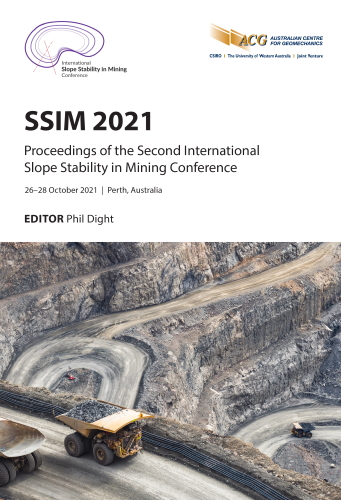Compaction faulting in thick mudstone: a slope stability case study of Prominent Hill open pit mine, South Australia

|
Authors: Fowler, MJ; Goodchild, DJ |
DOI https://doi.org/10.36487/ACG_repo/2135_20
Cite As:
Fowler, MJ & Goodchild, DJ 2021, 'Compaction faulting in thick mudstone: a slope stability case study of Prominent Hill open pit mine, South Australia', in PM Dight (ed.), SSIM 2021: Second International Slope Stability in Mining, Australian Centre for Geomechanics, Perth, pp. 315-340, https://doi.org/10.36487/ACG_repo/2135_20
Abstract:
This case study presents the conditions and performance of a sequence of weak sedimentary rocks at the OZ Minerals Ltd, Prominent Hill open pit mine located in South Australia. The weak rocks form a 100 m thick barren horizontally bedded cover sequence of Permian and Cretaceous age that overlie the ore-bearing Archaean to Mesoproterozoic basement rocks. Mining of the cover sequence rocks occurred in several stages between 2006 and 2012, during which a significant number of large-scale slope instabilities occurred. The failures occurred due to a unique set of geotechnical conditions. All slope instabilities were structurally bound by polygonal faults; a type of compaction discontinuity that occurs in thick, weak, saturated mudstone sequences. We highlight the origin and nature of polygonal faults and implication for slope stability and the engineering geology, geotechnical properties, pore pressure conditions, operational risk management, and design approaches including back and forward analysis. Comprehensive geotechnical monitoring and risk management was successfully employed to maintain safe mining operations. The slope instabilities proved manageable in part due to the long delay between excavation and collapse. A range of operational approaches to managing the instabilities were undertaken including unloading, buttressing, and managed collapse.
Keywords: mine slope stability, weak rocks, compaction faulting, polygonal faulting, hydromechanical coupling, Bulldog Shale, Prominent Hill
References:
Bishop, AW & Bjerrum, L 1960, The Relevance of Triaxial Test to the Solution of Stability Problems, Publication No. 34, Norwegian Geotechnical Institute, Oslo.
Cartwright, JA & Dewhurst, DN 1998, ‘Layer-bound compaction faults in fine-grained sediments’, GSA Bulletin, vol. 110, no. 10, pp. 1242–1257.
Duran, A 2014, ‘Comparison of field estimated strengths’, Proceedings of AUSROCK 2014: Third Australasian Ground Control in Mining Conference, The Australasian Institute of Mining and Metallurgy, Melbourne, pp. 101–106.
Dusseault, M, Cimolini, PH, Soderberg, H & Scafe, D 1983, ‘Rapid index tests for transitional materials’, Geotechnical Testing Journal, vol. 6, no. 2, pp. 64–72.
Geological Survey of South Australia 1993, The Geology of South Australia, Geological Survey of South Australia, Adelaide.
Martin, D & Stacey, P 2018, Guidelines for Open Pit Slope Design in Weak Rocks, CSIRO Publishing, Clayton.
OZ Minerals Ltd 2009, OZ Minerals Sustainability Report 2009, OZ Minerals Ltd, Adelaide, viewed 6 September 2021,
Sullivan, TD 2007, ‘Hydromechanical coupling and pit slope movements’, in Y Potvin (ed.), Slope Stability 2007: Proceedings of the 2007 International Symposium on Rock Slope Stability in Open Pit Mining and Civil Engineering, Australian Centre for Geomechanics, Perth, pp. 3–43,
Sullivan, TD 2020, ‘Hydromechanical coupling concepts for mine slopes’, in PM Dight (ed.), Slope Stability 2020: Proceedings of the 2020 International Symposium on Slope Stability in Open Pit Mining and Civil Engineering, Australian Centre for Geomechanics, Perth, pp. 66–98,
Watterson, J, Walsh, J, Nicol, A, Nell, PAR & Bretan, PG 2000, ‘Geometry and origin of a polygonal fault system’, Journal of the Geological Society, vol. 157, no. 1, pp. 151–162.
© Copyright 2025, Australian Centre for Geomechanics (ACG), The University of Western Australia. All rights reserved.
View copyright/legal information
Please direct any queries or error reports to repository-acg@uwa.edu.au
View copyright/legal information
Please direct any queries or error reports to repository-acg@uwa.edu.au